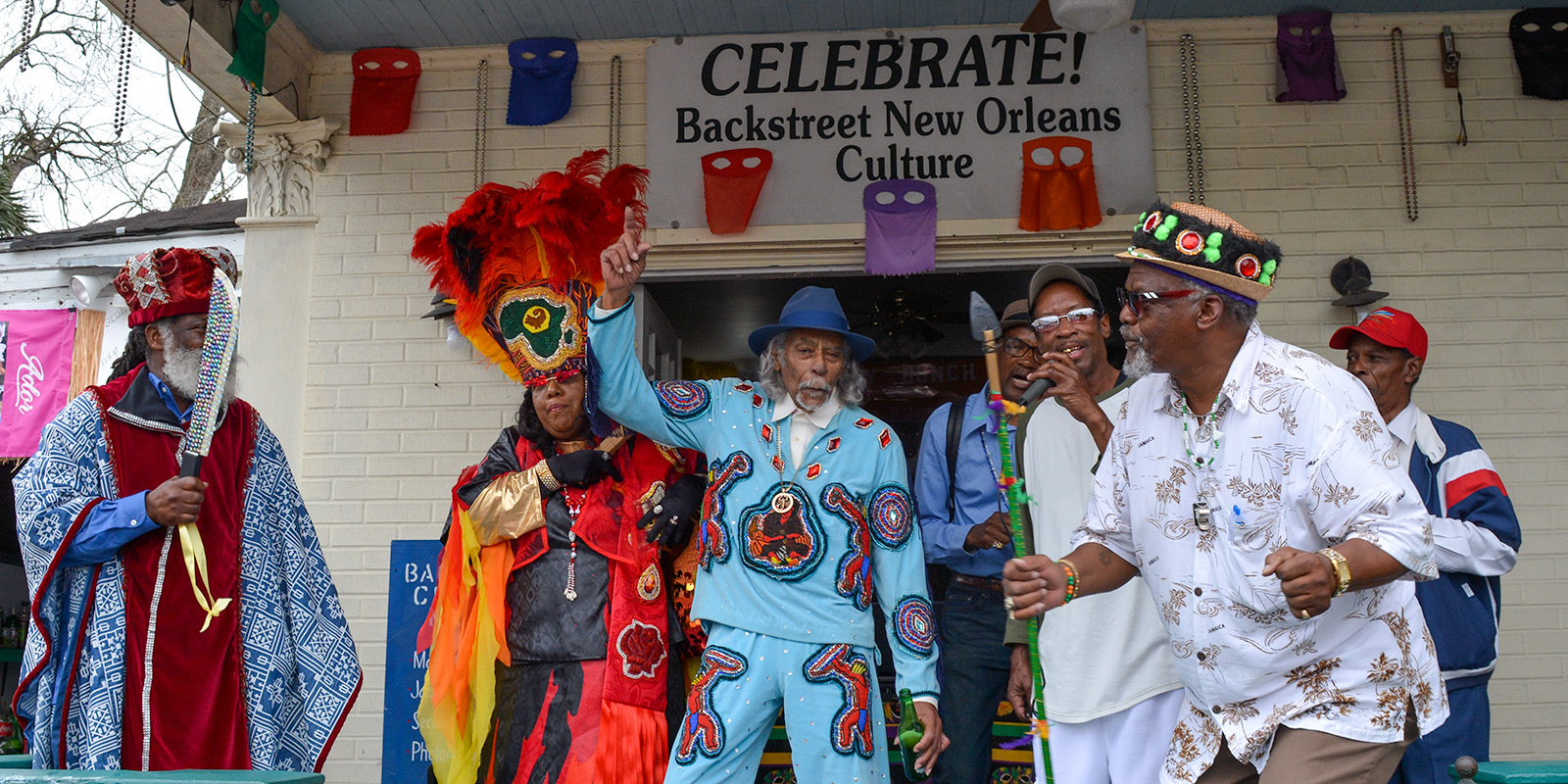“A Powerhouse of Knowledge”
The Backstreet Cultural Museum, which closed after sustaining structural damage from a fallen tree during Hurricane Ida in 2021, has found a temporary home at 1114 North Villere Street, in a small shotgun house on the grounds of the New Orleans African American Museum in the historic Tremé neighborhood. For 22 years, its extensive collection of photos and films, artifacts and regalia documenting Black cultural contributions to New Orleans was housed at the former Blandin funeral parlor at 1116 Henriette Delille Street, in Tremé across from the landmark Saint Augustine Catholic Church.
Sylvester Francis opened the museum in 1999, focusing on Mardi Gras Indians (also known as Black Masking Indians), Baby Dolls, the Mardi Gras skull and bone tradition, second lines, social aid and pleasure clubs and jazz funerals. He grew up in the adjoining Seventh Ward and became a documentarian almost by accident.
In 1979, he was a member of the Gentlemen of Leisure social aid and pleasure club. A photographer snapped him dressed in his finery and wanted $35 for a print. Francis grudgingly paid the man, then decided to buy a Super 8mm movie camera and a still camera — figuring they’d come in handy for personal use the next time his club paraded. But he wound up dropping out of the Gentlemen of Leisure and doggedly took to the streets, shooting jazz funerals, second lines and Black Carnival activities at a time when backstreet traditions were of little interest to museum curators. His tenacity earned him the nickname The Hawk, because he was always seeking out and zeroing in on the action, with his face behind a camera.
In 1984, recognizing the value of Francis’s work, the producers of New Orleans Jazz & Heritage Festival invited him to set up a display at the Fairgrounds. He’d continue to do so every year until 2020, when the festival was canceled because of Covid. (Francis died on September 1, 2020, at age 73.)
Practically from the first day he began shooting stills, Francis made a point of printing duplicates and gifting them to culture bearers whose images he’d captured. “The goal with the picture was, if I shoot the picture, I’ll give you one,” he said. “That was the whole key of my life.” There were no strings attached, nor was there any expectation that he’d receive something in return later.
The practice not only expanded his network of connections to musicians and others in the cultural community but created a deep reservoir of goodwill. When word got out that he was planning a museum, Francis later recalled, “people start calling me: ‘Come get this, come get that. You can have that because you always did give me a picture.’”
His wake-up call to become curator of his own museum came when he visited the Louisiana State Museum (now the New Orleans Jazz Museum) at the Old U.S. Mint, near the French Market. Upstairs was a single Indian suit “stuck in the corner, all dirty, raggedy. I say, ‘Oh, that’s a shame. I should open up a museum — quit messing around. What the hell?’” Eventually, the Backstreet Cultural Museum would boast the largest institutional collection of Indian suits, many of them donated by Francis’s close friend and supporter Victor Harris, Big Chief of the Mandingo Warriors “Spirit of the Fi Yi Yi” tribe. Its motto, “A Powerhouse of Knowledge,” reflected an educational mission.
In 2001, Backstreet hosted its first Mardi Gras Open House. The idea was to have a party on Carnival Day that would provide a refuge from all traffic, noise and congestion surrounding the Mardi Gras Under the Bridge celebration, underneath the freeway overpass along Claiborne Avenue — a traditional focal point of African American festivities. Francis had also grown disgusted at how establishments were gouging during Carnival, charging $5 for a can of beer that cost less than a dollar and $2 just to use a bathroom. His price for a beer: $2. Admission to the open house was free, and its popularity steadily grew as sundry maskers discovered that it offered an authentic slice of backstreet Carnival, with Indians, Baby Dolls and the Northside Skull and Bone Gang stopping by to enliven the revels.
Francis would emcee the event from the museum’s front porch, providing commentary and inviting icons such as Harris and Bruce “Sunpie” Barnes, a New Orleans musician and folklorist who leads the Northside Skull and Bone Gang, to take the microphone and stoke the crowd.
“You know you’re in the Tremé, dontcha?” Sunpie announced at the 2011 open house. “You’re in the backstreet! You don’t pay no hundred dollars, no four hundred dollars. Yeah, it’s the real thing. Talkin’ about real love. You can’t go buy this. It’s the real thrill.”
Executive Director Dominique Dilling Francis is determined to carry on her father’s legacy and bring the Backstreet Cultural Museum back strong. The museum, a nonprofit a 501(c)(3) organization, is accepting donations for the preservation of its collection and to help secure and maintain a permanent location.
MardiGrasTraditions.com

